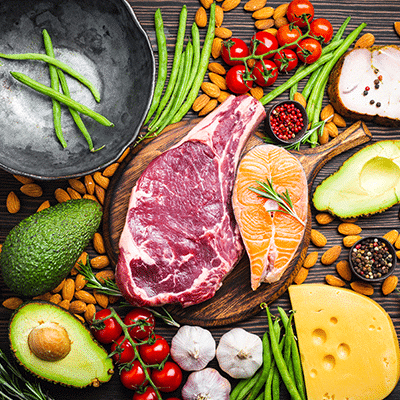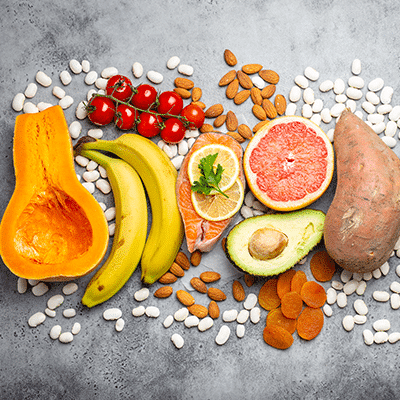Feeding Your Microbiome: Plus 5 Ways To Make It Healthier

You’ve heard a lot about the microbiome lately, right?
How important the microbiome is, and how important it is to have a wide variety of bacteria living there.
There isn’t really a lot of information out there though about HOW to get more diversity in your microbiome.
What foods to eat are a huge part of creating a more functional microbiome, but nobody is talking about how to do that.
Look no further, we are here to help!
Your Microbiome and The Bacteria Who Live There
Your microbiome is the world of bacteria that live inside your gut. They’re not only beneficial but necessary so that your body functions properly.
All of the bacterial species are there for a specific reason, but some should have higher quantities than others.
Here’s a breakdown of a few of the most common bacteria and what they do for your body.
The Effects of Macronutrients and Micronutrients on the Microbiome
Protein
Protein is essential for optimal function of muscles, bones, and many other body parts. Diets that contain protein lead to a greater diversity in gut bacteria.
You are able to get your protein from two main sources: animals and plants.
Animal-based proteins:
- Sources: meat, eggs, milk
- Increases: Bacteroides, Clostridia, Alistipes, and Bilophila
- Decreases: Bifidobacterium
Plant-based proteins:
- Sources: whey, peas, nuts, beans
- Increases: Bifidobacterium, Lactobacillus, and SCFA
- Decreases: Bacteroides fragilis, Clostridium perfringens
One study found that diets high in protein (especially animal proteins) and low in carbohydrates created a higher risk environment for irritable bowel diseases (IBD).
Fat
So we all have heard the battle of the fats — good versus evil, just like a comic series.
But is there really that much of a difference?
Yes!
Good fats include polyunsaturated and monounsaturated fats. They are found to decrease the occurrence of chronic illnesses.
- Sources: Olives/olive oil, avocados, fish oil
- Didn’t have any noticed effects on bacterial strains in feces.
Bad fats include saturated and trans fats.
They are known to increase your chances of cardiovascular diseases (CVD) and cholesterol problems.
- Sources: Butter, lard, fatty cuts of meat
- Increases: Faecalibacterium prausnitzii, Bacteroides, Bilophila
- Decreases: Lactobacillus intestinalis
Low-fat diets increased Bifidobacterium levels in fecal samples and reduced fasting glucose and cholesterol.
Carbohydrates
Carbohydrates are also broken down into two groups: digestible and non-digestible.
Digestible carbohydrates are broken down by enzymes in your small intestines.
- Sources: starches and sugars (glucose, fructose, sucrose, lactose)
- Increases: Bifidobacteria, SCFA
- Decreases: Bacteroides, Clostridium
Although sugars are a good source of digestible carbs, artificial sweeteners should be avoided. Many recent studies are showing that they may lead to certain illnesses, however, this is still in the researching phase.
Artificial sweeteners also affect the microbiome negatively by increasing Bacteroides and decreasing Lactobacillus strains.
Non-digestible carbohydrates (AKA prebiotics) go through your intestinal tract undigested until they reach the large intestines where they are fermented to create byproducts that can be reused by the body.
- Sources: Fibers (soybeans, unrefined wheat and barley, oats)
- Increases: Bifidobacteria, Lactic acid bacteria, Ruminococcus, E. rectale, Roseburia
- Decreases: IL-6 (a pro-inflammatory cytokine), Clostridium, Enterococcus
Probiotics
Probiotics are live strains of bacteria you ingest from fermented foods.
- Sources: cultured milk products, yogurt, kefir, kombucha
- Increases: Bifidobacteria, Lactobacillus
- Decreases: E. Coli, Helicobacter pylori
Polyphenols
Polyphenols are compounds found in foods that have extremely beneficial effects on the body.
- Sources: brightly colored fruits and vegetables, red wine, cocoa
- Increases: Bifidobacterium, Lactobacillus
- Decreases: Staphylococcus aureus, Salmonella typhimurium, Clostridium
Type of Diet
Westernized diets tend to contain more fats and proteins leading to more Firmicutes and Bacteroides.
Mediterranean diets tend to be high in polyphenolic substances that create a better diversity of bacteria.
Rural diets tend to be highest in fiber and lowest in animal proteins/fats out of the three diets mentioned. Those consuming this type of diet typically have high levels of Bacteroidetes.
5 Ways to Supercharge Your Gut Bacteria
Maintain a High Fiber/Prebiotic Intake
Fiber, once fermented in your gut, releases helpful products like short chain fatty acids (SCFA) that help to protect your body and increase functionality of cells.
In many different studies, it has been found that high-fiber diets create a better diversity in microflora.
Not only are fibers good for your microbiome, but the SCFA they produce help to fight many common diseases in the Western world (i.e. cardiovascular disease, obesity, Type II diabetes, and large bowel diseases).
Atrantil, being a prebiotic, helps to nourish your microbiome and create those important SCFA to help combat disease and boost immunity.
Make Sure You Are Getting Enough Iron
Iron is an extremely important micronutrient. Low levels of iron affect your microbiome and the rest of your body negatively and can lead to anemia.
Since patients suffering from IBD and Crohn’s disease have a tendency to have intestinal bleeding, keeping track of Iron is crucial to your health.
Fatigue, dizziness, headaches, and shortness of breath are all common symptoms of anemia and low iron levels. If you are experiencing any of these, contact your doctor to discuss potential Iron-deficiency.
Lactobacillus strains were found to be lower in a study of women in South India when they were anemic, as opposed to women of the same age and dietary intake who weren’t anemic.
Future studies need to be done to learn more about the correlation between low Lactobacillus strains and anemia.
Reduce Intake of Animal Proteins (Especially Red Meat)
Higher protein diets create for a slower progression of food through the bowels which creates more gases than with carbohydrate fermentation.
Putrefactive fermentation is pretty much the rotting of food in your digestive tract.
The increase of protein fermentation creates more gas and nitrogenous substrates in addition to protein-derived metabolites that all lead to putrefactive fermentation.
Putrefactive fermentation has been proven to lead to colorectal cancer (CRC) and IBD.
Trimethylamine N-oxide (TMAO) is a gas given off from bacteria breaking down red meats. TMAO has been proven to be a major factor in CVD.
Reduce Fat Intake
High-fat diets tend to increase the quantity of lipopolysaccharides (LPS) that circulate throughout your system.
While LPS are good for your immune system at the right doses, when their levels are too high they lead to unnecessary inflammation and intestinal permeability (IP).
IP allows for bacteria and other substances to pass freely through the intestinal barrier even if they shouldn’t.
High-fat diets also lead to increased levels of bile acids. This can lead to carcinogenesis, gastrointestinal diseases, and CRC.
Up Your Butyrate Production
Butyrate is one of the most common SCFA.
Butyrate is responsible for supplying colonocytes with energy, maintaining mucosal integrity and intestinal inflammation, and promoting stability of your genes.
Some of the main bacteria associated with producing butyrate include Roseburia, Clostridium cluster XIVa, and Faecalibacterium prausnitzii.
Some foods you can include in your diet to help promote Butyrate production include:
- Dairy products from cows (milk, butter)
- Breast milk (levels of butyrate depend upon and change with the age of the infant)
- Potatoes
- Bananas
- Legumes
- Fortified breakfast cereals
- Tortillas
Do you tend to have a more Westernized, Mediterranean, or rural diet?
How do you plan to nourish your microbiome?
Comment to let us know!
To recap watch our video below:


I’m on the FODMAP Diet for SIBO (took 2weeks of xifaxine). I’m not supposed to take pro-biopics. I’m lactose intolerant. The ALCAT test came back that I’m severely reactive to casein ( all milk products).. How should I be improving my Biome? I still have SIBO & I’m on the FODMAP Diet. I went from having diahrrea to being recently being constipated. I’m taking Miralax for that.
Hi Adele,
Great question! To improve your microbiome, you must have a good diet and get lots of polyphenols. Diets low in “bad” fats and rich in polyphenols, such as the Mediterranean diet, is a great example of a diet that will help to optimize the microbiome.
Polyphenols are key for nourishing the microbiome. Atrantil is an essential supplement to take to improve the microbiome. It is packed with polyphenols and works as a prebiotic in the colon before being broken down into beneficial postbiotics. We hope this helps to clarify.
Please let us know if we can be of further assistance.
Thank you and best wishes,
Team Atrantil